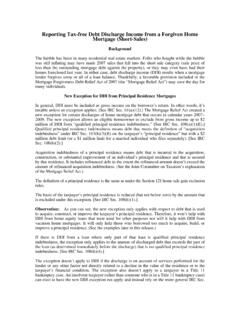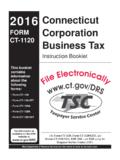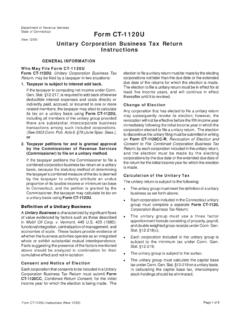Transcription of Deducting Cell Phone Expenses - Jennifer A Jones Ltd
1 Deducting Cell Phone Expenses Background As you know, cell phones are included in our beloved Tax Code s definition of listed property [IRC Sec. 280F(d)(4)(A)(v)]. Therefore, the stricter substantiation requirements for listed property apply to taxpayers who attempt to claim deductions for the business or investment use of cell phones [IRC Sec. 274(d)]. Clients Must Keep Records to Gain Any Tax Benefits Specifically, the taxpayer must keep adequate records or sufficient evidence to support the taxpayer s own statements regarding: (1) the amount of cell Phone expense; (2) the time and place of the expense; (3) the purpose of the expense; and (4) the relationship to the taxpayer of the person or persons involved in the expense [IRC Sec.]
2 274(d)]. It s not enough to merely keep copies of cell Phone bills and then claim the Expenses shown on the bills were incurred for business or investment reasons. If you don t believe that, we can cite a passel of recent Tax Court decisions such as Bogue, Stockwell, Gaylord, Moss, and Vaksman. In all these cases, claimed cell Phone deductions were completely disallowed because the taxpayers failed to adequately substantiate their business-related Expenses or did not substantiate them at all. For outbound cell Phone calls, your client can presumably meet the substantiation requirements by making appropriate notations on monthly bills from the service provider or on a printout of calls listed on the provider s website.
3 However, it may be necessary to keep a log of inbound calls ( Phone bills usually don t include any details about inbound calls, even though customers pay for them). Calculating Deductible Cell Phone Usage Charges The taxpayer s business-use percentage is needed to calculate his or her deductible cell Phone Expenses . The business-use percentage should be calculated based on the time the cell Phone is actually used (as opposed to calculating the percentage based on the time the Phone is available for use) [Reg. (e)(3)]. Of course, you can t convince most clients to make painstaking records of outgoing and incoming cell Phone calls for an entire year to establish the business-use percentage.
4 In the real world, accumulating accurate records for a representative month or two during the year should suffice. When the taxpayer pays separately for each call, the charges for business use apparently must be based on the actual expense incurred for each business call. However, as discussed later, the business-use percentage is still needed to calculate depreciation deductions for the cell Phone . When the client pays a flat monthly rate for cell Phone service, the deduction for business use presumably can be based on multiplying the business-use percentage by the monthly charges.
5 Warning: A recent Tax Court Summary Opinion might cause some alarm regarding flat monthly fees. In Soholt, the Tax Court opined that since the taxpayer paid a fixed monthly charge for his cell Phone service and used the cell Phone for both personal and business calls, it didn t actually cost him anything extra to use the Phone for business. Based on this misbegotten logic, the Tax Court would not have allowed deductions for the business portion of the monthly charges even if the taxpayer had kept adequate records (which he did not). Of course, the same misbegotten logic could be used to disallow most home office deductions and depreciation deductions for vehicles used for both business and personal driving.
6 The IRS apparently knows better than to make such bogus arguments. In this particular case, we are thankful that a Tax Court Summary Opinion cannot be cited as authority by the IRS or by anyone else. Depreciation Rules for Cell Phones A cell Phone s status as listed property has further implications. When the business-use percentage is 50% or less, depreciation must be calculated under the alternative depreciation system, or ADS. This translates into using the straight-line method over 10 years. [See IRC Sec. 280F(b) and Rev. Proc. 87-56, as modified by Rev. Proc.]
7 88-22.] In addition, the Section 179 deduction is not available for cell phones when business use is 50% or less [Reg. (d)]. When business use exceeds 50%, the cost of the Phone is typically written off as a 179 deduction. As listed property though, if the business-use percentage for a cell Phone previously used over 50% for business drops to 50% or less in a later tax year, the excess depreciation deductions (difference between cumulative deductions actually claimed and cumulative deductions that would have been allowed using straight-line over 10 years) must be recaptured [IRC Sec.
8 280F(b)(2)]. Preparation Pointer: Depreciation recapture amounts are computed and reported on Form 4797. The recapture is then reported as other income on the taxpayer s Schedule C, E, or F, depending on where the original deductions were claimed. Example 1: In 2007, Claude, a self-employed consultant, bought a new cell Phone for $150. He used it for both business and personal purposes. Assume Claude s 2007 business-use percentage was 40% based on the total number of minutes the Phone was used. Since the business-use percentage did not exceed 50%, Claude must depreciate the Phone straight-line over 10 years.
9 Even worse, only 40% (the business-use percentage) of the cell Phone s $150 cost can be depreciated. Finally, Claude cannot claim a Section 179 deduction for the cell Phone , since his business-use percentage did not exceed 50%. Observation: Since Claude s annual deprecation deduction for the cell Phone is only $6, it may not be worth bothering with. However, the deductible portion of Claude s monthly cell Phone charges probably is worth bothering with. Business Use of Cell Phones by Employees An individual who pays for a cell Phone that s used in rendering services as an employee (including as an employee of a closely-held C or S corporation) is not entitled to any deduction, unless he or she can satisfy both the convenience-of-the-employer and condition-of-employment tests.
10 In other words, the Phone must be obtained for the employer s convenience (not the employee s), and its use must be required in order for the employee to properly perform the duties of the job. [See Reg. (a), as well as Bogue and Stockwell.] In Cadwallader, the Tax Court opined that these two tests are automatically passed when the employee obtains equipment needed to fulfill his or her job responsibilities and thereby spares the employer from having to provide the equipment. (This decision was about an employee s computer used in his job, but the same principle should apply to cell phones.)








